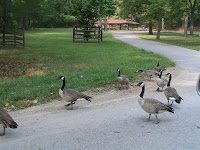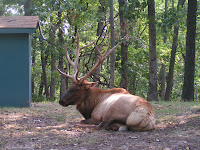Not far from our campground is one of St. Louis’ coolest places, Lone Elk Park, a wildlife management area run by the county park system. Evidently it's been here a long time, but neither Russ or I remember hearing about it growing up here. There are hiking trails, picnic areas in scenic spots, and you can even get a glimpse of the animals that live in the park. In a setting at the edge of the Ozark foothills, the park offers rolling hills, a quiet lake, and oak forests. The big  draw, however, is its drive-through animal range where bison, deer, elk and other animals roam in this 526-acre park. The only way to really view this area is in a motor vehicle which allows visitors a truly “up close” encounter with the animals in their natural habitat and that's exactly what we did on Tuesday morning.
draw, however, is its drive-through animal range where bison, deer, elk and other animals roam in this 526-acre park. The only way to really view this area is in a motor vehicle which allows visitors a truly “up close” encounter with the animals in their natural habitat and that's exactly what we did on Tuesday morning.
It was about 10am and initially we thought we might not see many animals since the best times are early morning or about dinner time, but as we rounded a curve in the road there were about a dozen geese standing in the middle of the road! We drove right past them (slowly of course), and they didn't budge. Obviously they're very used to cars. They're probably just wondering what kind of animals those are! We made th
Our next encounter was with a herd of elk in Elk's Hollow. Elk are the second largest species of deer in the world, and during the summer, they eat almost constantly. This herd we saw were all grazing and resting right along the roadside, and again the animals did not budge as we and another car slowly drove past. Only the males have antlers, which start growing in the spring and are shed eac h winter. Elk live 20 years or more in captivity but average 10 to 13 years in the wild. After taking a few photos, we continued on our drive and lying right there on the side of the road was this huge male elk with a full rack! What a majestic animal and how incredible to witness so close! The best was truly saved for last.
h winter. Elk live 20 years or more in captivity but average 10 to 13 years in the wild. After taking a few photos, we continued on our drive and lying right there on the side of the road was this huge male elk with a full rack! What a majestic animal and how incredible to witness so close! The best was truly saved for last.
Our tour complete, it was time to head out for a visit with Russ' Aunt Dori. She has lived at Autumn View Gardens, a retirement community here in St. Louis, for about 6 years and has her own little apartment there. Since we arrived around lunch time, she asked i f we'd like to join her in the dining room. They were serving polish sausage, sauerkraut, and German potato salad, and it sounded fine to us. We had a great visit with her, and she's just another one of those amazing 85 year old women!
f we'd like to join her in the dining room. They were serving polish sausage, sauerkraut, and German potato salad, and it sounded fine to us. We had a great visit with her, and she's just another one of those amazing 85 year old women!
Our tour complete, it was time to head out for a visit with Russ' Aunt Dori. She has lived at Autumn View Gardens, a retirement community here in St. Louis, for about 6 years and has her own little apartment there. Since we arrived around lunch time, she asked i

No comments:
Post a Comment